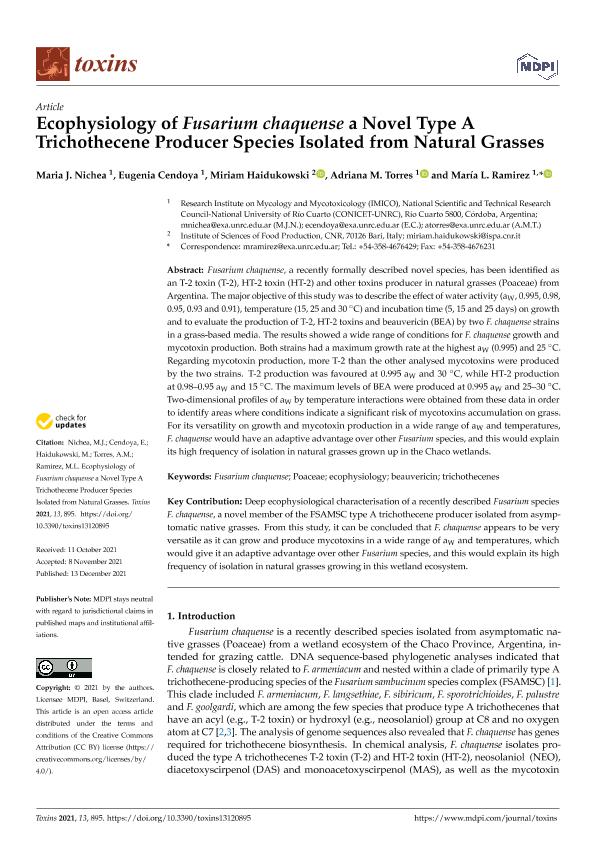Artículo
Ecophysiology of fusarium chaquense a novel type a trichothecene producer species isolated from natural grasses
Nichea, Maria Julia ; Cendoya, Eugenia
; Cendoya, Eugenia ; Haidukowski, Miriam; Torres, Adriana Mabel
; Haidukowski, Miriam; Torres, Adriana Mabel ; Ramirez, Maria Laura
; Ramirez, Maria Laura
 ; Cendoya, Eugenia
; Cendoya, Eugenia ; Haidukowski, Miriam; Torres, Adriana Mabel
; Haidukowski, Miriam; Torres, Adriana Mabel ; Ramirez, Maria Laura
; Ramirez, Maria Laura
Fecha de publicación:
12/2021
Editorial:
MDPI
Revista:
Toxins
ISSN:
2072-6651
Idioma:
Inglés
Tipo de recurso:
Artículo publicado
Clasificación temática:
Resumen
Fusarium chaquense, a recently formally described novel species, has been identified as an T-2 toxin (T-2), HT-2 toxin (HT-2) and other toxins producer in natural grasses (Poaceae) from Argentina. The major objective of this study was to describe the effect of water activity (aW, 0.995, 0.98, 0.95, 0.93 and 0.91), temperature (15, 25 and 30◦ C) and incubation time (5, 15 and 25 days) on growth and to evaluate the production of T-2, HT-2 toxins and beauvericin (BEA) by two F. chaquense strains in a grass-based media. The results showed a wide range of conditions for F. chaquense growth and mycotoxin production. Both strains had a maximum growth rate at the highest aW (0.995) and 25◦C. Regarding mycotoxin production, more T-2 than the other analysed mycotoxins were produced by the two strains. T-2 production was favoured at 0.995 aW and 30◦C, while HT-2 production at 0.98–0.95 aW and 15◦ C. The maximum levels of BEA were produced at 0.995 aW and 25–30◦ C. Two-dimensional profiles of aW by temperature interactions were obtained from these data in order to identify areas where conditions indicate a significant risk of mycotoxins accumulation on grass. For its versatility on growth and mycotoxin production in a wide range of aW and temperatures, F. chaquense would have an adaptive advantage over other Fusarium species, and this would explain its high frequency of isolation in natural grasses grown up in the Chaco wetlands.
Palabras clave:
FUSARIUM CHAQUENSE
,
POACEAE
,
ECOPHYSIOLOGY
,
BEAUVERICIN
,
TRICHOTHECENES
Archivos asociados
Licencia
Identificadores
Colecciones
Articulos (IMICO)
Articulos de INSTITUTO DE INVESTIGACION EN MICOLOGIA Y MICOTOXICOLOGIA
Articulos de INSTITUTO DE INVESTIGACION EN MICOLOGIA Y MICOTOXICOLOGIA
Citación
Nichea, Maria Julia; Cendoya, Eugenia; Haidukowski, Miriam; Torres, Adriana Mabel; Ramirez, Maria Laura; Ecophysiology of fusarium chaquense a novel type a trichothecene producer species isolated from natural grasses; MDPI; Toxins; 13; 12; 12-2021; 895-908
Compartir
Altmétricas



